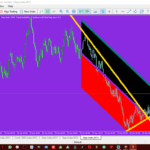Learn How to trade pullbacks with with hidden divergences. Traders frequently use divergence to determine the optimum times to enter trading positions. What is divergence, what are the many sorts of divergences, and how do you trade them? In today’s post, I will address these concerns.
types of divergences
When there is a divergence in the movement of the underlying asset’s price and the movement of a specific oscillator, we can talk about divergence. The Stochastic Oscillator, Moving Average Convergence Divergence, Relative Strength Index, and Commodity Chanel Index are just a few examples.
There are two types of divergences to be differentiated. Regular divergence and hidden divergence are two types of divergence.
regular divergence
The price is always fluctuating. It can occasionally result in higher highs or lower lows. We can talk about divergence when this happens on the price chart but the indicator line isn’t indicating the same thing.
Such a disparity between price action and indicator movement indicates that the current trend is weakening, and we can expect it to reverse.
However, pinpointing the precise moment when this might occur is tricky. As a result, using extra tools like trendlines or candlestick and chart patterns may be beneficial.
The bullish and the bearish divergence
Divergence can be bullish (positive) or bearish (negative).
During a downtrend, the positive divergence emerges. Although the price makes lower lows, the oscillator does not confirm this. Instead, it creates higher lows or double or triple bottoms. When utilizing the Stochastic Oscillator or the RSI, the latter is less relevant than the higher lows and occurs more frequently.
While the price is on an upswing, a bearish or negative divergence emerges. There are higher highs made by price activity that are not confirmed by indicator movement. Lower highs, as well as double or triple tops, may be produced by the oscillator.
What is a hidden divergence?
When the oscillating indicator makes a lower low or higher high while the price movement does not, we can call this a hidden divergence.
When the price is consolidating or making a correction within the current trend, this can happen. A hidden divergence is a continuation pattern because it indicates that the trend will most likely continue in the prior direction. As a result, hidden divergences can be used to trade with a trend. Pullbacks with hidden divergences are easier to spot.
The bullish and the bearish divergence
The hidden divergence, like the standard one, is divided into two types. The bullish divergence is one, while the bearish divergence is the other.
During an uptrend, the positive divergence develops when the indicator makes lower lows while the price does not. It indicates that the price is in a consolidation or correction phase, and that the trend will soon resume.
During a downtrend, bearish divergence might occur. Higher highs are shown by the oscillator, but not by the price action. The downward trend is projected to continue in the near future.
Trading divergences
Divergences do not provide significant signals to begin a trading position on their own. Nonetheless, they provide crucial information regarding the price’s future trajectory. A normal divergence indicates a trend reversal, whereas a hidden divergence indicates that the trend will continue.
To confirm the optimum entry point for your transaction, you’ll need to apply an additional strategy. It could be as basic as a trendline, a crossover of moving averages, or a candlestick pattern. Divergences can also be combined with trading envelopes or Bollinger Bands.
When a bearish reversal pattern emerges during an uptrend, the bearish divergence becomes more significant near the resistance trendline.
When a bullish reversal pattern develops during a downtrend, the bullish divergence is more pronounced near the support trendline.
Conclusion
Divergence is the difference between the price and the oscillating indicator’s movement. A divergence occurs when one is decreasing or rising while the other is not.
Regular and concealed divergences are the two types of divergences. The first warns of a probable shift in the trend’s direction. The concealed divergences indicate that the trend will most likely resume its path following a correction or brief consolidation.
Depending on whether they occur during a downtrend or an uptrend, both categories might be bullish or negative.
Use a different tool to find your entry point.






